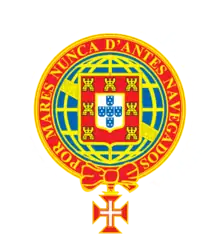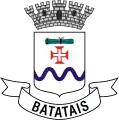Order of Christ Cross
The Order of Christ Cross (Portuguese: Cruz da Ordem de Cristo), also known as the Cross of Portugal (Cruz de Portugal) or the Portuguese Cross (Cruz Portuguesa), is a cross symbol of Portugal, originating in the Portuguese Order of Christ, founded in 1319. During the time of Prince Henry the Navigator, the cross came to be associated with the Portuguese discoveries and the Portuguese Empire. The cross can be considered a variant of the cross pattée or the cross potent.

History


As the Order of Christ, led by Prince Henry, the Navigator, was a leading developer of the Portuguese Discoveries, the Christ Cross was used on the sails of the Portuguese caravels, carracks and other ships involved in the exploration of the seas. Because of this, the emblem was forever associated with the Portuguese discoveries, making it one of the main symbols of the discoveries and of the Portuguese Overseas Empire.
After, Manuel, duke of Beja and governor of the Order of Christ, having become King of Portugal, the Cross of Christ came to be regarded and used as a national emblem of Portugal. It has since become a generic Portuguese and, later, Brazilian emblem. After Pedro declared the independence of Brazil, and became Emperor of Brazil, the Cross of Christ was also present in the coat of arms and flag of the former Empire of Brazil.
Since 1789, the Cross of Christ is depicted on the Sash of the Three Orders.
It was also the symbol of the Movimento Nacional-Sindicalista, a Portuguese political movement of the early 1930s.
Usage
Today, the Cross of Christ is present in many flags and emblems of Portugal and Brazil. Examples are the flags of the city of São Paulo and the Portuguese Autonomous Region of Madeira, the coat of arms of several Portuguese and Brazilian cities and municipalities, the badges of the Portuguese and Brazil national football teams and the roundels of the Portuguese Air Force aircraft.
Gallery
Historical examples
.svg.png.webp)
.svg.png.webp)

Royal standard of King John V of Portugal 
Flag of the Portuguese discoveries 
Colonial flag of the Cisplatina 
Flag of a Governor-General of the Portuguese Empire 
Flag of a Governor of the Portuguese Empire 
Flag of a Province Governor of the Portuguese Empire 
Flag of an Intendent of the Portuguese Empire 
Flag of an Officer of the Portuguese Empire 
War flag of Portugal during the Portuguese Restoration War 
Insignia of the Order of the Colonial Empire .PNG.webp)
Colonial coat of arms of Terceira Island 
Coat of arms of the Viriatos Portuguese Foreign Legion 
Flag of the Municipality of Portuguese Macau
Contemporary examples

Roundel of the Portuguese Air Force 
Flag of São Paulo, Brazil 
Flag of the Region of Madeira, Portugal .svg.png.webp)
Flag of the Chief-of-Staff of the Portuguese Navy 
Flag of Cananéia, Brazil 
Flag of Capim, Brazil 
Coat of arms of the 4th Aviation Battalion of the Brazilian Army 
Coat of arms of the Public Security Police of Madeira, Portugal 
Coat of arms of the Lisbon Geographic Society 
Coat of arms of Porto Alegre, Brazil 
Coat of arms of Alterosa, Brazil 
Coat of arms of Batatais, Brazil 
Coat of arms of Florianópolis, Brazil 
Coat of arms of Joinville, Brazil 
Coat of arms of Penafiel, Portugal .png.webp)
Coat of arms of Vila do Bispo, Portugal 
Coat of arms of Guetim, Portugal 
Coat of arms of Paio Mendes, Portugal 
Coat of arms of Paradela, Portugal
See also
References
| Wikimedia Commons has media related to Order of Christ cross. |
- Christ Knights’ Order (Portugal) Flags of the World